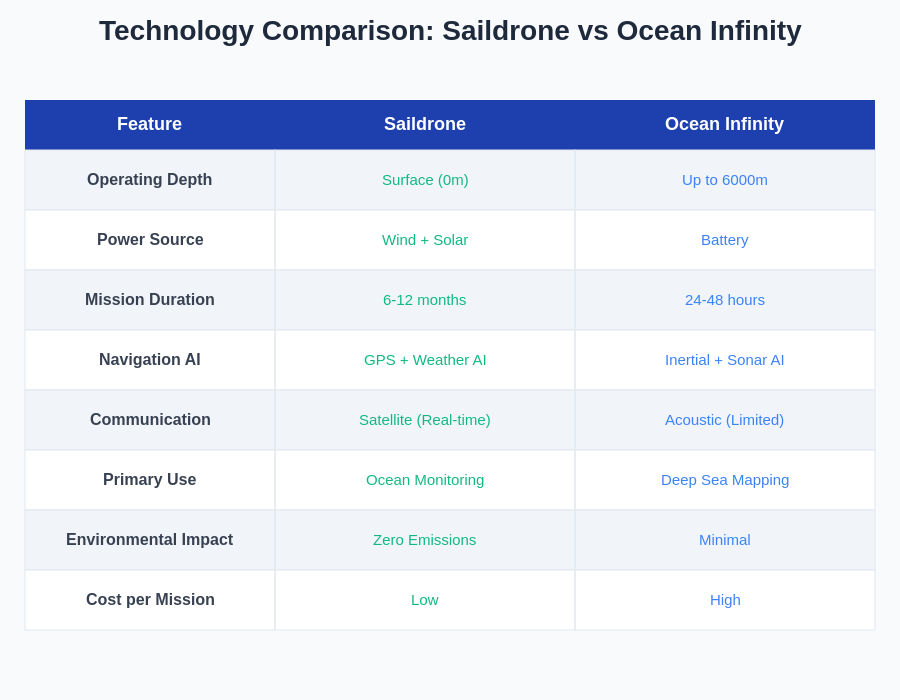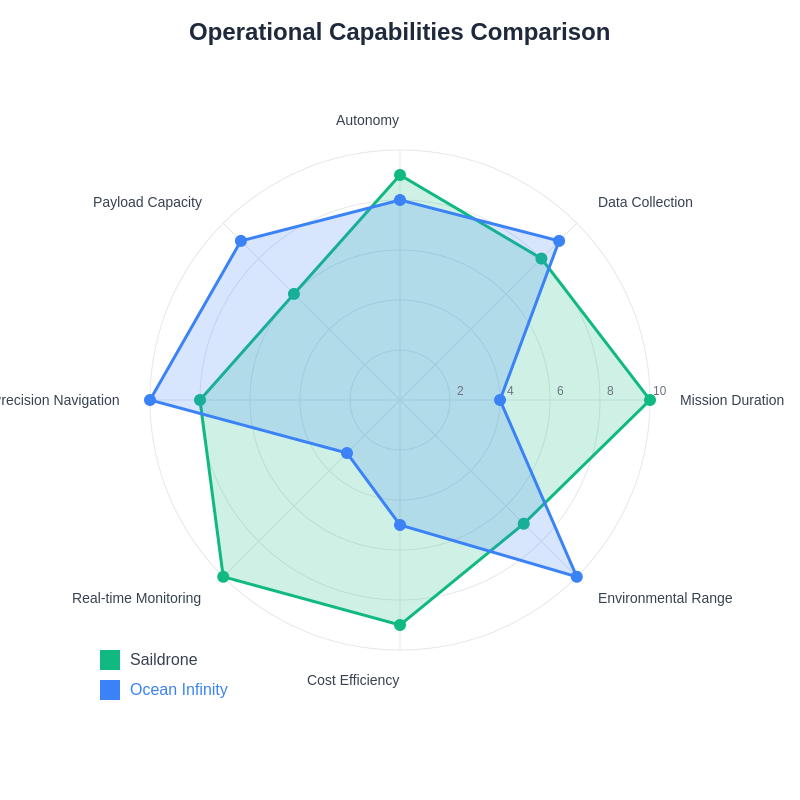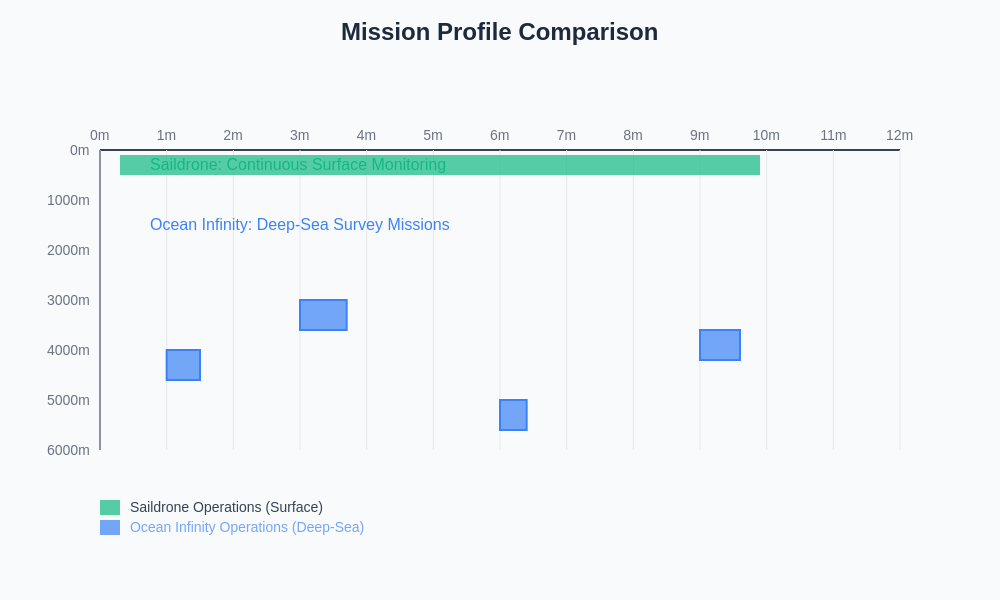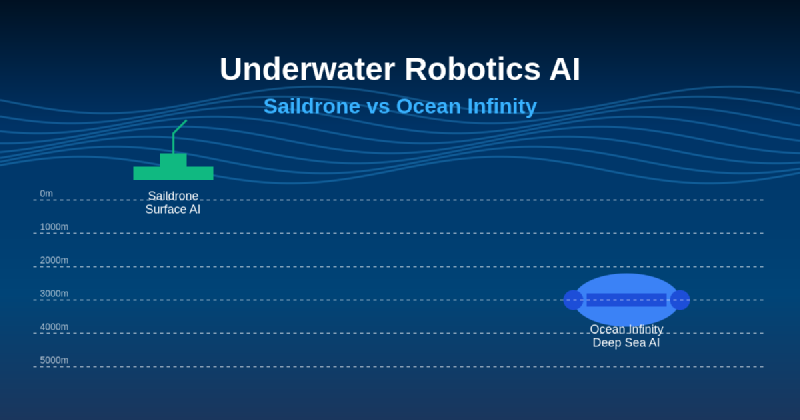The vast expanse of Earth’s oceans remains one of the last frontiers for technological exploration, with artificial intelligence and robotics converging to unlock the mysteries hidden beneath the waves. In this revolutionary landscape of underwater exploration, two pioneering companies have emerged as leaders in autonomous marine robotics: Saildrone with their innovative surface-based autonomous vehicles and Ocean Infinity with their sophisticated deep-sea exploration platforms. These technological marvels represent the cutting edge of AI-driven ocean exploration, each offering unique approaches to understanding and mapping our planet’s underwater environments.
Discover the latest AI innovations in robotics as autonomous systems continue to push the boundaries of what’s possible in marine exploration and environmental monitoring. The integration of artificial intelligence into underwater robotics has transformed oceanographic research from a primarily human-operated endeavor into an autonomous, data-driven science that operates continuously across vast oceanic territories.
The Evolution of Autonomous Marine Exploration
The development of AI-powered underwater robotics represents a fundamental shift in how humanity approaches ocean exploration and scientific research. Traditional oceanographic methods relied heavily on manned vessels, limited-duration expeditions, and expensive research infrastructure that could only cover small portions of the ocean at any given time. The emergence of autonomous systems has democratized ocean exploration, enabling continuous monitoring, large-scale data collection, and unprecedented access to previously unreachable marine environments.
Saildrone’s approach to autonomous marine exploration focuses on surface-based vehicles that harness wind and solar power to conduct long-duration missions across vast oceanic distances. These sophisticated platforms integrate advanced AI algorithms for navigation, obstacle avoidance, and autonomous decision-making while collecting comprehensive environmental data through an array of sensors and monitoring equipment. The company’s vehicles have demonstrated remarkable capabilities in weather monitoring, fisheries assessment, and oceanographic research, operating autonomously for months at a time without human intervention.
Ocean Infinity has pursued a different but equally innovative path, developing advanced underwater robotics systems capable of operating at extreme depths and conducting detailed seabed mapping, wreck location, and deep-sea exploration missions. Their platforms utilize cutting-edge AI for underwater navigation, object recognition, and autonomous mission planning in environments where GPS signals are unavailable and communication with surface operations is severely limited. This approach has revolutionized deep-sea exploration, enabling detailed investigation of previously inaccessible ocean floors and underwater geological formations.
Saildrone’s Surface-Based Autonomous Revolution
Saildrone’s technological innovation centers around the development of wind and solar-powered autonomous surface vehicles that can operate independently for extended periods while collecting high-quality oceanographic and atmospheric data. These remarkable platforms represent a convergence of renewable energy technology, advanced materials science, and sophisticated AI systems that enable autonomous navigation across open ocean environments. The vehicles are equipped with comprehensive sensor suites capable of measuring everything from water temperature and salinity to atmospheric conditions and marine life populations.
The artificial intelligence systems governing Saildrone vehicles incorporate machine learning algorithms for weather prediction, route optimization, and adaptive mission planning that allows the platforms to respond dynamically to changing ocean conditions. These AI systems process real-time environmental data to make autonomous decisions about navigation routes, data collection priorities, and energy management strategies that maximize mission duration and scientific value. The vehicles can adjust their behavior based on weather patterns, ocean currents, and mission objectives while maintaining continuous communication with remote operators through satellite links.
Experience cutting-edge AI capabilities with Claude for advanced autonomous system development and intelligent decision-making algorithms that power next-generation robotics platforms. Saildrone’s integration of AI extends beyond simple navigation to encompass predictive analytics, autonomous fault detection, and intelligent data prioritization that ensures critical scientific measurements are captured and transmitted even under challenging operational conditions.
The environmental impact of Saildrone’s approach represents a significant advancement in sustainable ocean exploration technology. By utilizing renewable energy sources and eliminating the need for fossil fuel-powered support vessels, these platforms can conduct extensive ocean monitoring missions with minimal environmental footprint. The AI systems optimize energy consumption by predicting weather patterns and adjusting operational parameters to maximize the utilization of available wind and solar resources, enabling missions that can last for months without requiring external energy inputs.
Ocean Infinity’s Deep-Sea Exploration Mastery
Ocean Infinity has established itself as a leader in deep-sea robotics through the development of sophisticated autonomous underwater vehicles capable of operating at extreme depths while conducting detailed mapping and exploration missions. Their technology platforms represent the pinnacle of underwater robotics engineering, incorporating advanced AI systems for navigation, obstacle avoidance, and autonomous mission execution in some of the most challenging environments on Earth. These systems operate in complete darkness, under extreme pressure, and without direct communication links to surface operations.
The company’s approach to underwater AI navigation relies on advanced sensor fusion techniques that combine sonar data, inertial navigation systems, and machine learning algorithms to create detailed three-dimensional maps of underwater environments while simultaneously tracking vehicle position and orientation. These AI systems process vast amounts of sensor data in real-time to identify underwater obstacles, interesting geological features, and potential exploration targets while maintaining precise navigation accuracy over extended mission durations.
Ocean Infinity’s autonomous underwater vehicles have demonstrated remarkable capabilities in challenging deep-sea missions, including the location of lost aircraft, detailed mapping of previously unexplored ocean floors, and comprehensive surveys of underwater archaeological sites. The AI systems governing these platforms can autonomously adjust mission parameters based on discovered conditions, prioritize exploration targets based on scientific or commercial value, and adapt to unexpected underwater terrain while maintaining operational safety and mission effectiveness.
The technological sophistication of Ocean Infinity’s platforms extends to their ability to operate as coordinated fleets of autonomous vehicles, with AI systems managing communication between multiple platforms, coordinating search patterns, and optimizing collective mission efficiency. This multi-vehicle approach enables comprehensive coverage of large underwater areas while providing redundancy and enhanced data collection capabilities that surpass what individual platforms could achieve independently.
Comparative Analysis of AI Navigation Systems
The fundamental differences between Saildrone and Ocean Infinity’s AI navigation approaches reflect the distinct challenges and opportunities presented by surface versus underwater operations. Saildrone’s systems benefit from continuous GPS access, satellite communication capabilities, and extensive weather data that enable sophisticated predictive analytics and long-term mission planning. Their AI algorithms can process global weather models, ocean current predictions, and historical data to optimize routes and timing for maximum scientific value and operational efficiency.
Ocean Infinity’s underwater AI navigation systems face significantly more challenging operational constraints, operating without GPS signals, limited communication capabilities, and in environments where visibility is severely restricted. Their AI systems must rely on sophisticated sensor fusion techniques, advanced mapping algorithms, and autonomous decision-making capabilities that can function independently for extended periods without external guidance or real-time human oversight.
Enhance your research capabilities with Perplexity for comprehensive analysis of complex technical systems and emerging robotics technologies that drive innovation in autonomous exploration platforms. The AI systems employed by both companies represent different but equally sophisticated approaches to autonomous navigation, each optimized for their specific operational environments and mission requirements.

The fundamental technological differences between Saildrone and Ocean Infinity platforms reflect their distinct operational environments and mission objectives, with each system optimized for maximum effectiveness within their respective domains.
Both platforms utilize machine learning algorithms for pattern recognition, environmental prediction, and adaptive behavior modification, but the specific implementations vary significantly based on operational constraints and available sensor data. Saildrone’s systems can leverage cloud-based processing capabilities and extensive historical datasets, while Ocean Infinity’s platforms must rely on onboard processing power and real-time sensor data interpretation for autonomous decision-making.
Sensor Technology and Data Collection Capabilities
The sensor suites employed by Saildrone and Ocean Infinity represent state-of-the-art technology for environmental monitoring and data collection in marine environments. Saildrone’s surface platforms incorporate comprehensive atmospheric and oceanographic sensors capable of measuring air and water temperature, humidity, barometric pressure, wind speed and direction, wave height and period, water salinity and conductivity, dissolved oxygen levels, and various biological indicators. These sensors provide continuous data streams that enable detailed characterization of ocean-atmosphere interactions and environmental conditions.
Ocean Infinity’s deep-sea platforms utilize advanced sonar systems, high-resolution cameras, manipulator arms, and specialized sensors for geological and biological sampling. Their AI systems process sonar data to create detailed three-dimensional maps of underwater terrain while simultaneously identifying objects of interest for closer investigation. The integration of multiple sensor modalities enables comprehensive characterization of deep-sea environments and the autonomous identification of features that merit detailed examination.
The data processing capabilities of both platforms represent significant advances in real-time analytics and autonomous decision-making. Saildrone’s AI systems can process weather data to predict optimal sailing conditions, analyze biological sensor data to identify areas of high marine life concentration, and integrate multiple data streams to provide comprehensive environmental assessments. Ocean Infinity’s systems process sonar data for navigation and mapping while using computer vision algorithms to identify and classify underwater objects and geological features.
Both companies have developed sophisticated data compression and transmission systems that enable efficient communication of collected data to research institutions and operational centers. These systems utilize AI algorithms to prioritize data transmission based on scientific value, operational requirements, and available communication bandwidth, ensuring that critical information reaches researchers and decision-makers in near real-time despite the challenges of marine communication environments.
Environmental Impact and Sustainability Considerations
The environmental implications of autonomous marine robotics extend far beyond their immediate operational impact, encompassing broader considerations of sustainable ocean exploration and environmental monitoring capabilities. Saildrone’s renewable energy approach represents a paradigm shift toward zero-emission ocean exploration that can provide continuous environmental monitoring without contributing to marine pollution or carbon emissions. Their AI systems optimize energy utilization to maximize mission duration while minimizing environmental impact through intelligent route planning and adaptive energy management.
Ocean Infinity’s approach to environmental sustainability focuses on maximizing the efficiency and effectiveness of deep-sea operations to minimize the overall environmental impact of underwater exploration activities. Their AI systems enable precise navigation and efficient mission execution that reduces the time and resources required for deep-sea exploration while providing more comprehensive data collection than traditional methods. This approach reduces the need for multiple expeditions and minimizes disturbance to sensitive deep-sea ecosystems.
Both companies have contributed significantly to environmental monitoring and climate research through their autonomous platforms, providing continuous data collection capabilities that enhance scientific understanding of ocean dynamics, climate change impacts, and marine ecosystem health. The AI systems enable automated detection of environmental anomalies, pollution incidents, and ecological changes that might otherwise go unnoticed until significant damage has occurred.
The long-term environmental benefits of autonomous marine robotics include enhanced early warning systems for environmental threats, improved understanding of ocean-climate interactions, and more effective monitoring of marine protected areas and endangered species populations. These capabilities represent a significant advancement in humanity’s ability to understand and protect marine environments through technology rather than intrusive research methods.
Commercial Applications and Market Impact
The commercial applications of advanced underwater robotics AI extend across multiple industries, creating new opportunities for offshore energy development, marine resource management, shipping and logistics optimization, and environmental consulting services. Saildrone’s platforms have demonstrated significant value in fisheries management, providing detailed data on fish populations, migration patterns, and ecosystem health that enables more sustainable fishing practices and improved resource management decisions.
Ocean Infinity’s deep-sea capabilities have revolutionized offshore oil and gas exploration, underwater infrastructure inspection, and marine archaeology through their ability to conduct detailed underwater surveys with unprecedented accuracy and efficiency. Their AI systems enable autonomous identification of geological features, pipeline integrity assessment, and archaeological site documentation that previously required expensive manned submersible operations or surface vessel support.
The integration of AI into marine robotics has created new business models based on autonomous data collection services, predictive analytics for marine operations, and continuous monitoring capabilities that provide ongoing value rather than one-time survey results. These developments have democratized access to high-quality oceanographic data and made advanced marine technology accessible to smaller research institutions and commercial operators.
Both companies have demonstrated the potential for autonomous marine robotics to reduce operational costs while improving data quality and safety outcomes across various marine applications. The AI systems enable continuous operation without the need for expensive support vessels, reduce human exposure to dangerous marine environments, and provide more comprehensive data collection than traditional methods.

The comprehensive comparison of operational capabilities reveals distinct strengths and specializations for each platform, with Saildrone excelling in mission duration and cost efficiency while Ocean Infinity demonstrates superior deep-sea navigation precision and payload capacity.
Future Technological Developments and Innovation Trends
The future trajectory of underwater robotics AI points toward increasingly sophisticated autonomous systems capable of complex decision-making, collaborative operations, and adaptive learning from operational experience. Saildrone continues to advance their renewable energy integration, AI navigation algorithms, and sensor technology to enable longer missions, more comprehensive data collection, and enhanced autonomous capabilities for complex oceanographic research applications.
Ocean Infinity is pursuing developments in swarm robotics, advanced AI coordination systems, and enhanced deep-sea manipulation capabilities that will enable more complex underwater operations and collaborative exploration missions. Their future platforms are expected to incorporate advanced machine learning capabilities that can adapt to new underwater environments and mission requirements through autonomous learning and optimization processes.
The convergence of AI advancement, sensor technology improvement, and renewable energy integration promises to create even more capable autonomous marine platforms that can operate independently for extended periods while providing unprecedented insights into ocean dynamics and marine ecosystems. These developments will likely enable new applications in climate monitoring, marine conservation, and deep-sea resource exploration that are currently beyond the capabilities of existing technology.
Both companies are investing heavily in edge computing capabilities, advanced materials science, and next-generation sensor technology that will further enhance the autonomy and capabilities of their platforms. The integration of quantum computing, advanced AI architectures, and novel sensor modalities represents the next frontier in autonomous marine exploration technology.
Collaborative Potential and Industry Integration
The potential for collaboration between surface-based and deep-sea autonomous platforms represents an exciting opportunity for comprehensive ocean exploration that combines the strengths of both approaches. Integrated missions utilizing Saildrone’s surface platforms for communication relay, weather monitoring, and surface data collection in coordination with Ocean Infinity’s deep-sea platforms could enable unprecedented comprehensive ocean exploration capabilities.
The development of standardized communication protocols, data sharing frameworks, and collaborative AI systems could enable seamless integration between different autonomous platforms to create comprehensive ocean monitoring networks. These integrated systems could provide real-time environmental monitoring, early warning capabilities for oceanographic events, and detailed characterization of ocean-atmosphere interactions across multiple depth levels.
Industry partnerships between autonomous platform developers, research institutions, and commercial operators are creating new opportunities for innovative applications and technological advancement. The sharing of AI algorithms, sensor technologies, and operational expertise across different organizations is accelerating the development of more capable and cost-effective autonomous marine systems.
The future of underwater robotics AI lies in the integration of multiple platforms, sensor modalities, and analytical capabilities to create comprehensive understanding of marine environments and their complex interactions with global climate systems. This collaborative approach promises to unlock new insights into ocean dynamics while providing practical solutions for marine resource management and environmental protection.

The distinct mission profiles of Saildrone and Ocean Infinity platforms demonstrate complementary approaches to ocean exploration, with Saildrone providing continuous long-term surface monitoring while Ocean Infinity conducts intensive short-duration deep-sea investigations.
Implications for Ocean Science and Research
The impact of advanced underwater robotics AI on oceanographic research extends far beyond improved data collection capabilities, encompassing fundamental changes in how marine science is conducted and how researchers approach complex oceanographic questions. The continuous data streams provided by autonomous platforms enable longitudinal studies of ocean dynamics, climate interactions, and ecosystem changes that were previously impossible due to logistical and financial constraints.
The AI systems employed by both Saildrone and Ocean Infinity have enabled new research methodologies based on adaptive sampling, autonomous hypothesis testing, and real-time data analysis that can guide mission parameters and research priorities. These capabilities allow researchers to respond dynamically to emerging phenomena and focus resources on the most scientifically valuable observations and measurements.
The democratization of ocean exploration through autonomous platforms has enabled smaller research institutions and developing nations to participate in cutting-edge oceanographic research without requiring extensive marine infrastructure or expensive research vessels. This broader participation in ocean science has accelerated scientific discovery and improved global understanding of marine systems and their role in planetary climate dynamics.
The comprehensive datasets generated by autonomous marine platforms are enabling new applications of machine learning and artificial intelligence to oceanographic research, creating opportunities for pattern recognition, predictive modeling, and automated discovery of previously unknown oceanographic phenomena. These capabilities represent a fundamental shift toward data-driven ocean science that can process vast amounts of information to identify subtle patterns and relationships that might escape human observation.
The revolutionary advances in underwater robotics AI demonstrated by Saildrone and Ocean Infinity represent just the beginning of a transformation that will reshape humanity’s relationship with the ocean and our understanding of marine environments. As these technologies continue to evolve and mature, they promise to unlock new scientific discoveries, enable more effective environmental protection, and provide sustainable solutions for marine resource management that will benefit future generations. The convergence of artificial intelligence, advanced robotics, and renewable energy technology in marine applications demonstrates the potential for technology to address some of humanity’s greatest challenges while expanding our knowledge of the natural world in ways that were previously unimaginable.
Disclaimer
This article is for informational purposes only and does not constitute professional advice. The information presented is based on publicly available data about underwater robotics technologies and their applications. Readers should conduct their own research and consult with qualified professionals when considering the implementation of autonomous marine systems. The performance and capabilities of robotic platforms may vary depending on specific operational conditions, mission requirements, and environmental factors.
